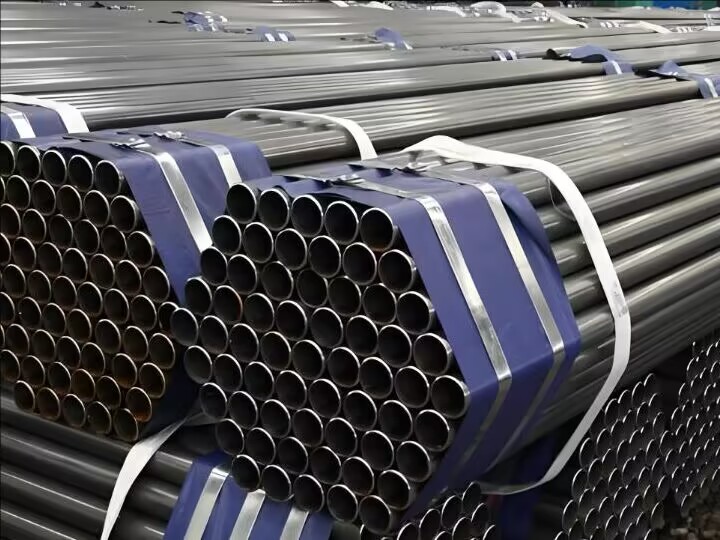The average person's understanding of the steel pipe is not perfect, that the steel pipe is just a pipe made of steel pipe, do not know more classification and application. Welded steel pipe is a common type of steel pipe in modern engineering applications, it has a unique manufacturing process and excellent comprehensive properties, and has been widely used in many fields. This paper will introduce the welded steel pipe and its classification method in detail.

What is welded steel pipe?
Welded steel pipe refers to the steel pipe with joints on the surface after the steel strip or steel plate is bent and deformed into a round or square shape. The billet used for welded steel pipe is steel plate or strip steel. Welded steel pipes have the characteristics of simple production process, high production efficiency, many varieties and specifications, and less equipment investment, but the strength of welded steel pipes is generally lower than that of seamless steel pipes.
Classification of welded steel pipes
Classification by welding method:
ERW steel pipe: local heating and welding of the joint of the steel belt through resistance heating and pressure, suitable for small and medium-sized diameter pipelines, often used to transport oil, natural gas and other vapor and liquid objects.
LSAW steel pipe: The steel plate is cut and bent into a pipe and welded along the long direction of the pipe. The weld is in a straight line. It has a high bearing capacity and is suitable for pipelines with large diameters and thick walls.
SSAW steel pipe: After the spiral winding of steel strip is formed, the weld is formed by spiral welding, which is often used for large diameter and thick wall pipes.
Classification by material:
Carbon steel welded pipe: made of ordinary carbon steel, with good plasticity and welding properties, widely used in general conveying systems and structural engineering.
Low alloy welded pipe: Add appropriate alloying elements (such as chromium, molybdenum, etc.) on the basis of carbon steel to improve the high temperature resistance, pressure resistance and creep resistance of the pipe, suitable for high temperature and high pressure environments, such as boilers and oil and gas transmission pipelines.
Low alloy welded pipe in the manufacturing process is often used with carbon steel welded pipe similar process, the main types can be summarized into the following categories:
Low-Alloy ERW
Low-Alloy LSAW steel pipe
Low Alloy spiral welded steel pipe (Low-alloy SSAW)
Each of these three types has its own advantages, and the suitable products can be selected according to the specific working conditions (such as temperature, pressure, conveying medium, etc.) and design requirements. Generally, in high temperature, high pressure and corrosive environment, low alloy welded steel pipe with its excellent heat treatment performance and creep resistance, become an important material in boiler tubes, oil and gas transmission pipelines and other fields.
Stainless steel welded pipe: stainless steel material, with excellent corrosion resistance and health properties, often used in food, medicine and chemical industry and other areas with high environmental requirements.
Stainless steel welded pipes can be classified from multiple angles, of which there are mainly the following two categories:
According to the welding process classification: resistance welding stainless steel pipe, straight seam welding stainless steel pipe, spiral welding stainless steel pipe.
According to the material can be divided into:
Austenitic stainless steel welded pipe: such as 304, 316 stainless steel, with excellent corrosion resistance and toughness, suitable for food, medicine, chemical industry and other areas with high health requirements.
Ferritic stainless steel welded pipe: such as 430 stainless steel, corrosion resistance is good but the strength and toughness are relatively low, mainly used in decoration, construction and other fields.
Martensitic stainless steel welded pipe: such as 410, 420 stainless steel, high hardness, but slightly weak corrosion resistance, often used in applications requiring higher mechanical strength.
Duplex stainless steel welded pipe: both the advantages of austenite and ferrite, with high strength and good corrosion resistance, suitable for chemical, petroleum and Marine engineering and other harsh environment.
Alloy welded pipe: The use of special alloy materials, such as high-temperature alloy pipe, etc., such products for specific conditions (such as high temperature, corrosive media) have better comprehensive performance.
According to the welding process can be divided into: resistance welding alloy steel pipe, straight seam welding alloy steel pipe, spiral welding alloy steel pipe.
Classification by alloy composition and performance grade:
Common low-alloy welded pipe: The use of common low-alloy components, such as Cr, Mo, etc., typical products include ASTM A335 standard series P5, P9, P11, P22, etc. These products are mainly used in boilers, heat exchangers and oil and gas transmission.
High temperature and high pressure alloy welded pipe: For extreme conditions (such as high temperature, high pressure and high corrosion environment), choose a better alloy ratio, such as ASTM A335 P91/P92 grade products, with better creep resistance, heat resistance and oxidation resistance.
In summary, according to the different welding process and material, welded steel pipes can be divided into a variety of types, and different types of products have their own advantages in performance, application and price.
